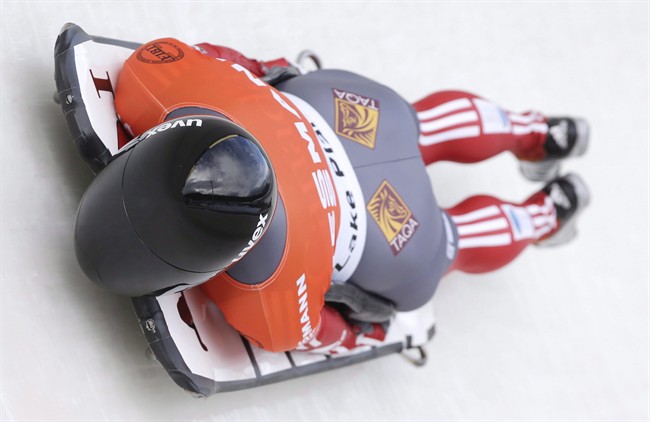CALGARY – Two promising women on Canada’s skeleton team stopped competing because of head injuries. Mellisa Hollingsworth and Sarah Reid hope they’re not next.

The 2014 Olympic medal hopefuls say they feel good and their heads are clear, but they’re concerned about concussion symptoms returning after their first slides of the season later this week.
“At this point, I feel that could be the one thing that stands in the way of me competing in the Olympics,” said Reid, a bronze medallist at this year’s world championship.
Canadian head coach Duff Gibson instituted a cap on training runs this season at three per day for all athletes regardless of their health. Only those who are free of concussion symptoms are allowed to train.
While not scientifically proven, there’s anecdotal information suggesting heavy run volume can cause what’s known in sliding circles as “sled head,” particularly for athletes who have had a concussion and are thus more susceptible to another.
“We’ve learned some hard lessons trying to be tough,” Gibson said. “We’ve lost some World Cup medallists.
Darla Deschamps-Montgomery, the wife of Olympic champion Jon Montgomery, and 2010 Olympian Amy Gough quit the sport because of concussions in recent years. They have not returned to the national team.
Reid, from Calgary, and Hollingsworth, from Eckville, Alta., were both concussed in crashes a few years ago. But both developed headaches last season without major wrecks.
Reid withdrew from the final World Cup race of last season, a test race of the 2014 Olympic track in Sochi, Russia, after her training runs.
“I didn’t hit my head, but it was a really bumpy track and I did a lot of runs,” she said. “I just started feeling not myself.”
Watch: Athletes begin to ramp up their training for the Sochi Olympics in Calgary.
As in other sports, concussions in skeleton were once shook off as a “bump to the head” and athletes returned to training and racing as soon as they could.
In skeleton, athletes slide head first down a track on sleds at speeds up to 140 kilometres per hour, which creates a strong gravitational pull on their bodies.
The rougher the track, the more their heads and necks shake. Their heads are exposed to knocks along the wall if they make a steering mistake.
“Your chin actually drags on the ice and if you go into a corner wrong that G-force is even stronger,” Deschamps-Montgomery explained. “We call it being ‘Mike Tysoned’ and getting constantly punched in the face.”
Hollingsworth won Olympic bronze in 2006 and owns five world championships medals. She had debilitating headaches running from her temple to the back of her head earlier this year.
She’s convinced the high number of training runs she and her teammates did on the Whistler, B.C., track prior to the 2010 Winter Games was hard on their brains.
They were encouraged to get in as much training as possible in Whistler to exploit home-track advantage and put in as many as six runs per day.
“The run volume we had in Whistler was too much,” Hollingsworth said. “We didn’t know that then. It’s unfortunate and we’ll probably have some pretty angry days ahead of us because of what we’ve been through. At the same time, we didn’t know.”
Hollingsworth, who turns 33 on Friday, isn’t yet ready to call an end to her career, but says she’ll do so if concussion symptoms resurface.
“Then I’m done,” she said. “It’s not worth it. I will know. I’ll wake up and be in that fog and have those headaches and that’s not how I want to live.”
Gibson, the 2006 Olympic champion, says he was never diagnosed with a concussion while he competed, but is sensitive to bright light and loud noises after his racing career.
“There’s so much we don’t know about it,” he said. “To use what’s become cliche, we’re learning more and more that we don’t know anything.”
The skeleton team adopted a concussion protocol of pulling athletes from training and competition when they have concussion symptoms. The sliders aren’t allowed to return until they’ve achieved the markers indicating their brains have healed.
The skeleton racers are also equipped with accelerometers in their helmets to measure the forces on the human body while training at different tracks. Gibson doesn’t know yet if the information will be useful in preventing head injuries.
He admits all his athletes aren’t happy with a cap on training passes.
“There are athletes who say “I’ve never had a symptom. Why are you limiting me in this way?'” he said.
But Gibson vows to hold fast to the three-per-day rule at a November training camp on the Sochi track, where his athletes will get key preparation for the Winter Games.
“When we were in Sochi, the track was really rough and people were really upset about it,” he said. “Other countries were like ‘yeah, we can take it.’ They haven’t paid the price we have yet.”
The Canadian team has video of training runs and races on the Sochi track that they can study. Gibson says watching how other racers navigate the track and visualizing a perfect race on it are as important to preparation as sliding.
“We can be as good as we can possibly be and not do five runs a day,” he said.


Comments